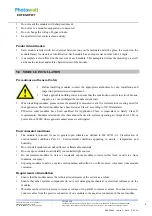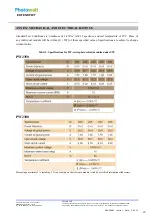
EDF ENR PWT
D06
‐
P06
‐
01
Indice
1
Date:
3
‐
01
‐
13
EDF
ENR
PWT
Société
par
actions
simplifiée
à
associé
unique
–
au
capital
de
37
505
000
€
‐
N°
513
281
972
RCS
NANTERRE
Siège
social
:
100
Esplanade
du
Général
de
Gaulle
–
Cœur
Défense
–
Tour
B
92932
Paris
La
Défense
cedex
.
33,
Rue
Saint
Honoré
‐
Z.I.
Champfleuri
38300
Bourgoin
Jallieu
‐
France
Tel
:
04
74
93
80
20
‐
Fax
:
04
74
93
80
40
Do not mark the modules with sharp instrument.
Do not leave a module unsupported or unsecured.
Do not change the wiring of bypass diodes.
Keep all electrical contacts clean and dry.
Product identification
Each module is fitted with two identical barcodes (one on the laminate under the glass, the second on the
module frame) for its unique identification. Each module has a unique serial number with 13 digits.
A nameplate is also affixed on the rear side of each module. This nameplate defines the model type, as well
as the main electrical and safety characteristics of the module.
5.0 MODULE INSTALLATION
Precautions and General Safety
Before installing modules, contact the appropriate authorities for site, installation and
inspection permission and requirement. .
Check applicable building codes to ensure that the construction or structure (roof, facade,
support, etc.) can withstand the module system load.
When installing modules, please ensure the assembly is mounted over a fire resistant roof covering rated for
the application. Photowatt modules have been listed as Class C according to UL790 standard.
PW-series solar modules have been qualified for Application Class A (equivalent to Safety Class II
requirements). Modules rated under this class should be used in systems operating at voltage above 50V or
power above 240W, where general contact access is anticipated.
Environmental conditions
The module is intended for use in general open climates, as defined in IEC 60721-2-1: Classification of
environmental conditions Part 2-1: Environmental conditions appearing in nature - temperature and
humidity.
Do not install modules near naked flames or flammable materials.
Do not expose modules to artificially concentrated light sources.
Do not immerse modules in water or constantly expose modules to water (either fresh or salt) (i.e. from
fountains, sea spray).
Exposing modules to salt (i.e. marine environments) and sulfur (i.e. sulfur sources, volcanoes) risks module
corrosion.
Requirements of installation
Ensure that the module meets the technical requirements of the system as a whole.
Ensure that other systems components do not exert damaging mechanical or electrical influences on the
modules.
Modules can be wired in a series to increase voltage or in parallel to increase current. To connect in series,
connect cables from the positive connectors of one module to the negative connectors of the next module.
4










